2 Earth Systems
This chapter is a pre-review version
Learning Outcomes
By the end of this section you should be able to
- Distinguish isolated, closed and open systems
- Enumerate the main “spheres” of the Earth
- Describe the hydrologic cycle, that moves water through Earth systems
Types of system
In studying something as complex as our planet, the Earth, it’s helpful to divide it into manageable parts: we look at portions of the whole. We refer to these manageable parts as systems. In dealing with the Earth, we will treat the Atmosphere, the Hydrosphere, the Biosphere, and the Geosphere as systems. The materials of each system have a lot in common. For example, the materials of the Atmosphere are mostly gases. Nonetheless, these systems do exchange matter and energy with each other: for example, atmospheric moisture falls as rain and is transferred from the Atmosphere to the Hydrosphere in the process. Systems may be classified based on these exchanges.
Isolated systems
An isolated system is a system that exchanges neither matter nor energy with its surroundings. Stated in this way, an isolated system is an idealized concept – something that doesn’t really exist. If a system were completely isolated we wouldn’t be able to observe it. However, it’s possible for a system to come close to being isolated. Our Solar System, the subject of another chapter, consists of the Sun and the bodies that orbit around it. It receives very little energy from other stars in the Galaxy, and it exchanges only tiny amounts of matter with the rest of the Universe. It therefore can be treated for some purposes as an isolated system. Nonetheless it loses energy steadily to the rest of the Universe, so this it is not really isolated: so far as we know, no system is truly isolated, except the Universe as a whole.

Closed systems
A related concept is a closed system. A closed system neither gains nor loses matter to or from its surroundings, but it does exchange energy with surrounding systems. Once again a perfectly closed system is hard to find! However, the planet Earth itself (including everything out to the outermost Atmosphere) is an approximately closed system. It certainly exchanges energy with its surroundings: Earth’s main source of energy is the Sun. However, the amount of matter exchanged by Earth with the rest of the solar system is very small. Certainly, meteorites fall on the Earth from time to time, and very light gases, like hydrogen and helium, drift off into space from Earth’s atmosphere, but these exchanges of matter are very small in comparison with the mass of the Earth. For most purposes we can treat the Earth as a closed system.
Open systems
Most of the systems within the Earth are open systems. This applies particularly to living things. Animals and plants trap energy from their surroundings to power their life processes, and they acquire matter (in the form of food, water, and atmospheric gases like oxygen) and release, or excrete, matter to their surroundings. Depending on the type of investigation we are carrying out, a system may be as small as a single cell in an organism, or it may be something as large as the entire Geosphere. In between these extremes we can recognize systems such as the Atmosphere, an ocean, an island, a forest, a tree, or a single organism like you or me.
Spheres
Some of the most important Earth systems are referred to as “spheres” and are arranged one inside each other (more or less) starting on the outside with the Atmosphere, and ending on the inside with the Geosphere – everything below the surface of the solid Earth.
Atmosphere
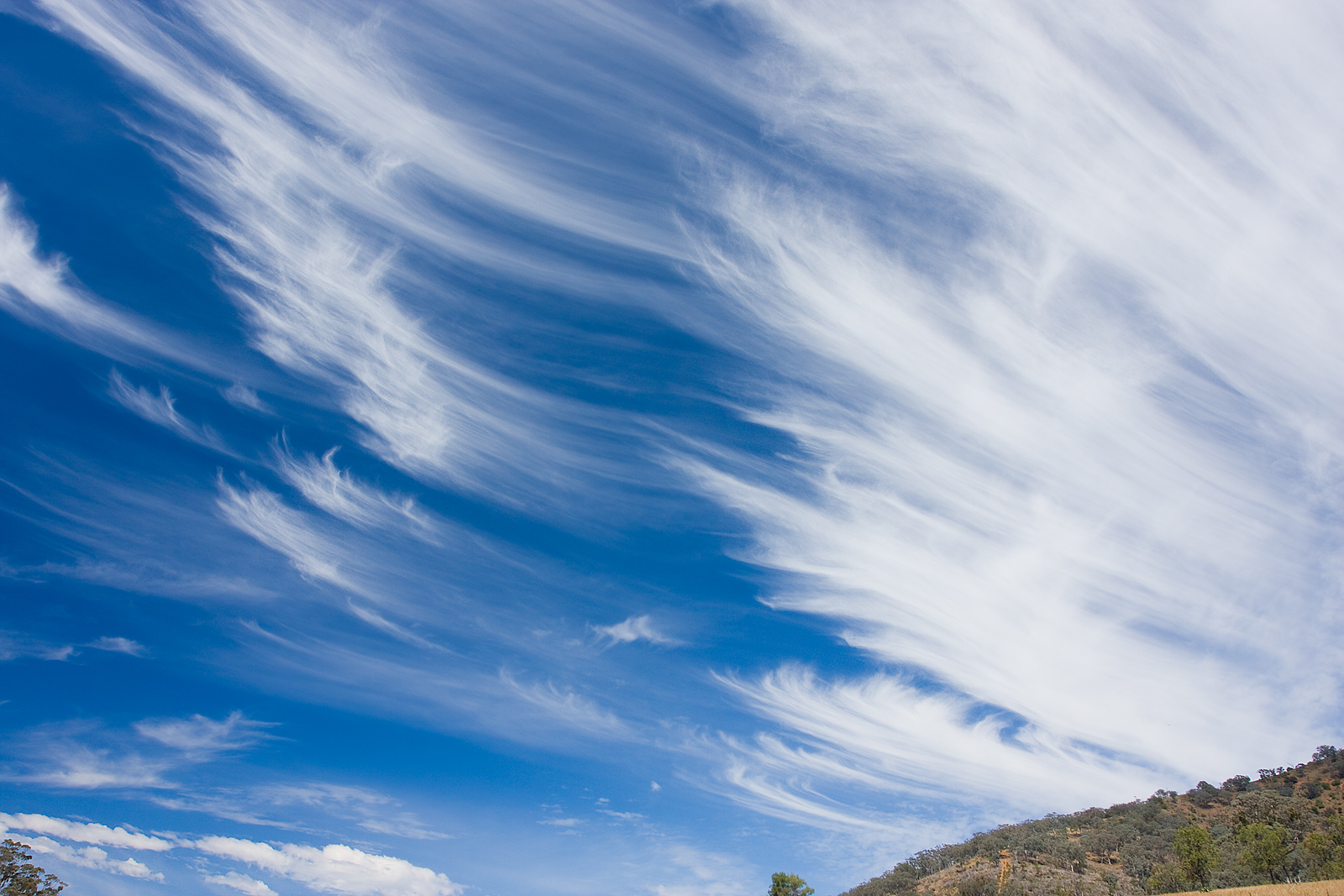
The outermost of these systems, or spheres is Earth’s atmosphere, the envelope of gas that surrounds our planet. The Atmosphere is a mixture of gases, but dominantly consists of nitrogen, followed by oxygen as the second most abundant component. The third most abundant component in most places is water vapour, but the proportion of water in the Atmosphere is extremely variable. The next two components in order of abundance are the inert gas Argon, and the “greenhouse gas” carbon dioxide. The Atmosphere is held in place by the force of gravity, but it gets progressively more dilute outwards into space. The edge of the Atmosphere is therefore hard to define, but 100 km is a reasonable approximation for the thickness of Earth’s atmosphere.
Hydrosphere
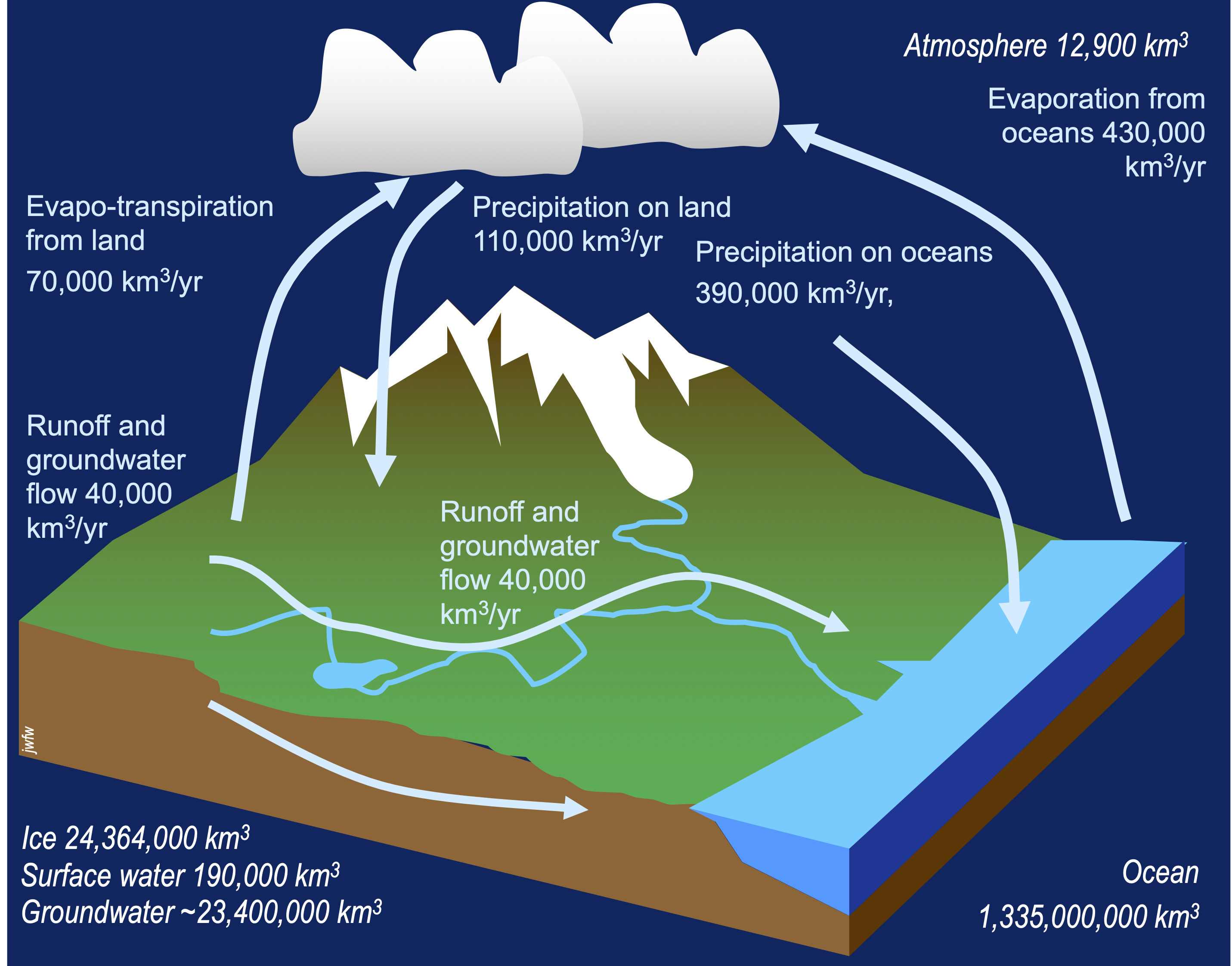
Atmospheric water is continuously exchanged with the layer of water, in both liquid and solid (ice) form that partially covers the surface of the solid Earth. The Hydrosphere includes the oceans, water on the surface of the land such as rivers and lakes, water in the form of snow and ice (including glaciers) and water that’s present in pore spaces within the Geosphere, known as groundwater. Much of this water contains dissolved material that can include gases trapped from the Atmosphere, and minerals dissolved from the Geosphere.
Some Earth systems scientists define a separate Cryosphere system that includes only water in the solid state, ice. This is reasonable because the processes that affect ice are in many cases different from those affecting liquid water. In some types of behaviour (e.g. the slow flow of glaciers) ice actually behaves like a soft rock. Nonetheless, because the effects of ice on the landscape cannot be completely separated from those of running water, we here treat the Cryosphere as part of the larger Hydrosphere.
Biosphere
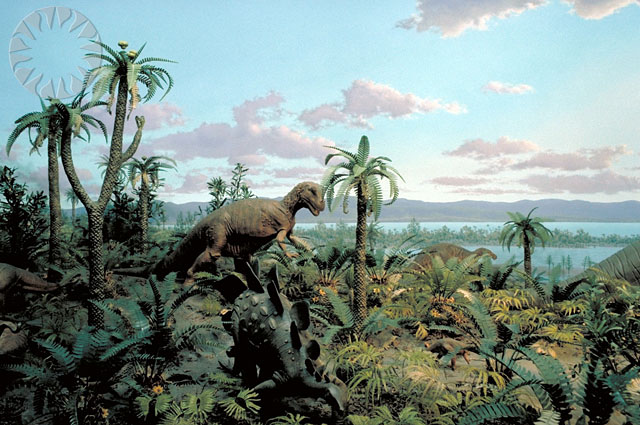
The Biosphere is a huge and exceedingly complex system comprising all the world’s living animals and plants, together with their non-living remains and products on the Earth’s surface. All life on Earth depends on water to some extent, so much of the biosphere is deeply entangled with the Hydrosphere. However, as we shall see, life on Earth also interacts with the Atmosphere and with the geosphere.
Because humans have had such an enormous impact on the Earth in the last few thousand years, some Earth scientists like to designate humans and their products as a separate Anthroposphere. However, the duration of this human dominance over the Biosphere is extremely short when compared to the length of time life has existed: our species have existed for less than one ten-thousandth of the history of life on Earth. We therefore mainly treat them as part of the Biosphere, though a very influential one.
Geosphere

The final sphere that we need to consider is the solid Earth, known as the Geosphere, a little over 12,000 km in diameter. By both mass and volume, this is by far the largest of the spheres. Most of the Geosphere is made of solid chemical substances called minerals, that occur in mixtures that we know as rocks. Traditionally, the Geosphere has been divided into 3 parts. In the middle, the Core is believed to be mostly liquid iron, and is the source of the Earth’s magnetic field. The Core is a little less than half the diameter of the Earth. Outside the core is the solid Mantle, consisting predominantly of magnesium and iron silicate minerals, over 3000 km thick. The third layer, the Crust, is very thin (5–75 km) but is hugely varied. The Earth’s crust is studied by geologists who are able to see and sample its rocks when doing fieldwork. Information about deeper parts of the Crust, together with the Mantle and the Core, mostly comes from geophysicists, who use the Earth’s physical properties (measurements of seismic waves, gravity, magnetism, and electrical properties) to probe the interior. Together, geologists and geophysicists are known as geoscientists.
The name “Crust” is a little misleading because it suggests a rigid shell over a softer interior. The Earth does have a rigid outer shell, but it’s now known that it’s about 100 km thick, comprising both the Crust and a rigid outer layer of the Mantle. Together, these are known as the Lithosphere. The Lithosphere is divided into plates that move around over a deeper part of the Mantle that is able to flow, called the Asthenosphere.
We will look at the evidence for these processes and their impact on humans in a later section.
Cycles
You may have noticed that water exists within all four of the “spheres” named above, and is continuously being transferred from one sphere to another. However, the total amount of water within the Earth doesn’t change very much, so we can represent the transfers of water within the Earth system as a cycle, the hydrologic cycle.
Water is just one material that is cycled through the different spheres of the Earth. Each of the chemical components of the Earth takes part in its own cycle. Some of these cycles are very important for humans. For example the carbon cycle is inextricably bound up with the use of energy by living thngs (including humans), while the nitrogen cycle is critically important for agriculture. Therefore, in addition to cycles defining the flow of materials, we will also study the energy cycle that describes the flow of solar energy, together with geothermal and tidal energy, through the Earth system, affecting all of the “spheres”.
Reservoirs, fluxes and residence times
Each of these cycles can be thought of as series of reservoirs connected by a series of flows or fluxes. The figure below shows the amounts of water stored and moving in various parts of the hydrologic cycle. Notice that the reservoirs contain amounts of material at any moment, whereas the size of a flux is measured as an amount per unit time, like cubic metres per second, or cubic kilometres per year, or perhaps gigatonnes per million years: regardless of the units, there’s always a time unit involved in the measurement of a flux.
If the size of a reservoir in a cycle does not change, then the flux in to the reservoir must be the same as the flux out. Under these circumstances it’s possible to divide the size of a reservoir by the flux in or out to get a residence time. For example the residence time of water in the Atmosphere (just under ten days) is the average time that a water molecule spends between being evaporated from the Hydrosphere and falling again as rain or snow.
If the fluxes in and out of a reservoir are not equal, then the reservoir will change size over time. Such effects are known as forcings. In efforts to understand the effects of humans on the Earth it has become particularly important to understand forcings, and we will meet them again in dealing with climate change. For simplicity in this section, the fluxes in and out of each reservoir in the Hydrosphere are regarded as constant and approximately equal.
Example: the Water cycle
Let’s put this into practice by looking at one of the most important cycles for life on Earth, the water cycle or hydrologic cycle. Water exists in all the spheres of the planet, and it exists in three different forms: as a solid it is known as ice; as a liquid, just known as water; and as a gas, known as water vapour or steam.
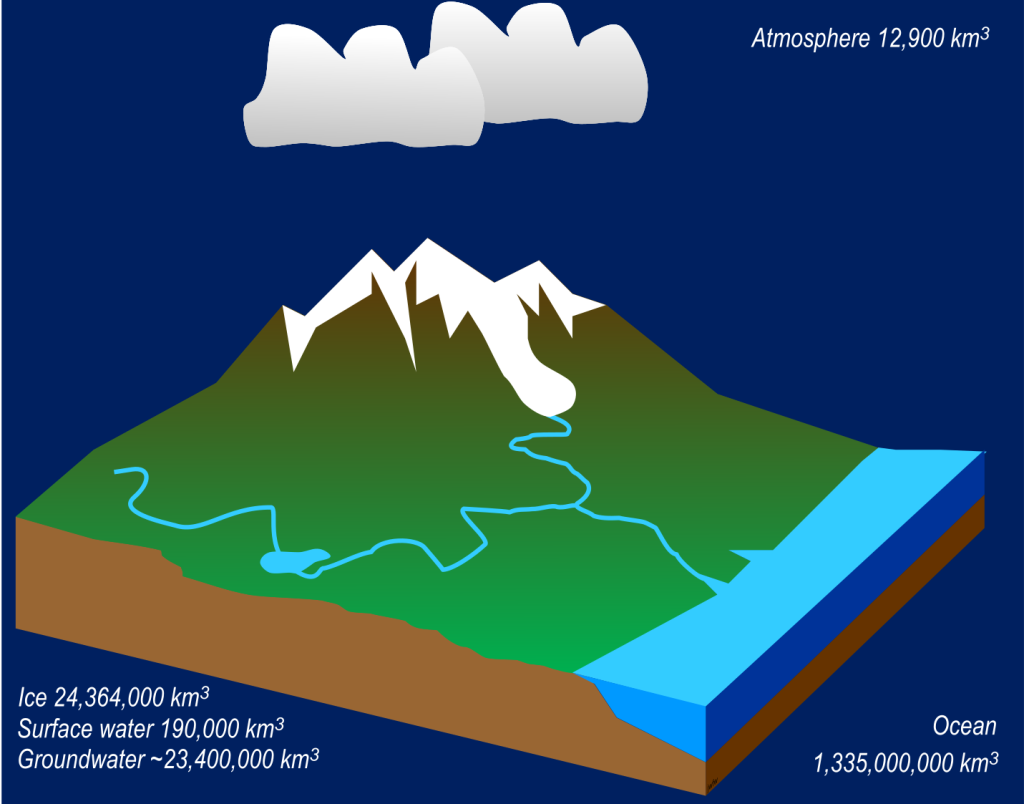
There are five main reservoirs of water in the Earth[1].
- By far the largest is marine water: the oceans and seas, which contain about 1.335 x 109 km3 (or 1.335 billion cubic kilometres) of water, or about 96.5% of the total.
- The next largest reservoir is ice, in the form of ice sheets, ice caps, and other glaciers, and thinner layers of snow and ice on the land and sea. The total amount of ice is estimated to be equivalent to 2.4364 x 107 km3 (just over 24 million cubic kilometres) of water. (The actual volume is a bit larger because water expands as it freezes.)
- Third, by most estimates, is groundwater: water contained in the Geosphere, mostly in small spaces between the grains of sediments and rocks. The exact amount of free water[2] is hard to measure, but a good estimate is slightly less than the amount of ice: 2.34 x 107 km3 (23.4 million cubic kilometres).
- Fourth is water on the land surface, in lakes, rivers, and wetlands. It amounts to about 190,000 km3.
- Fifth in quantity is water vapour in the Atmosphere, at only 12,900 km3.
- Finally, there is water in the Biosphere. Although very important to living things, the total amount of water they contain is an order of magnitude less than the water in the Atmosphere: 1,120 km3. Despite its importance, our analysis of the water cycle will treat this water as part of the surface water on land, and as part of marine water in the ocean.
One of the most important fluxes in the water cycle is the transfer of water from the oceans to the Atmosphere by evaporation. Heat from the sun converts liquid water to water vapour at a rate of about 430,000 km3 per year. A smaller amount of water leaves the land surface in the same way, but some of this water is delivered to the Atmosphere from the leaves and other surfaces of plants, a process known as transpiration. The combination of evaporation and transporation is known as evapo-transpiration. About 70,000 km3 of water enters the Atmosphere this way per year.
Water doesn’t stay in the Atmosphere for long. It falls as precipitation (rain and snow) onto both land and sea. The land surface accumulates water at about 110,000 km3/yr by this process, while the sea accumulates about 390,000 km3/yr.
Notice that more water falls on the land than leaves it by evapo-transpiration, and less water falls on the sea than leaves it by evaporation. The difference is made up by the flow of water from the land to the sea. This takes place by flow of glaciers, rivers etc. over the land surface and by slow flow of groundwater beneath the Earth’s surface. These processes transfer about 40,000 km3/yr of water from land to sea, making up for the mismatch between the precipitation and evaporation rates.
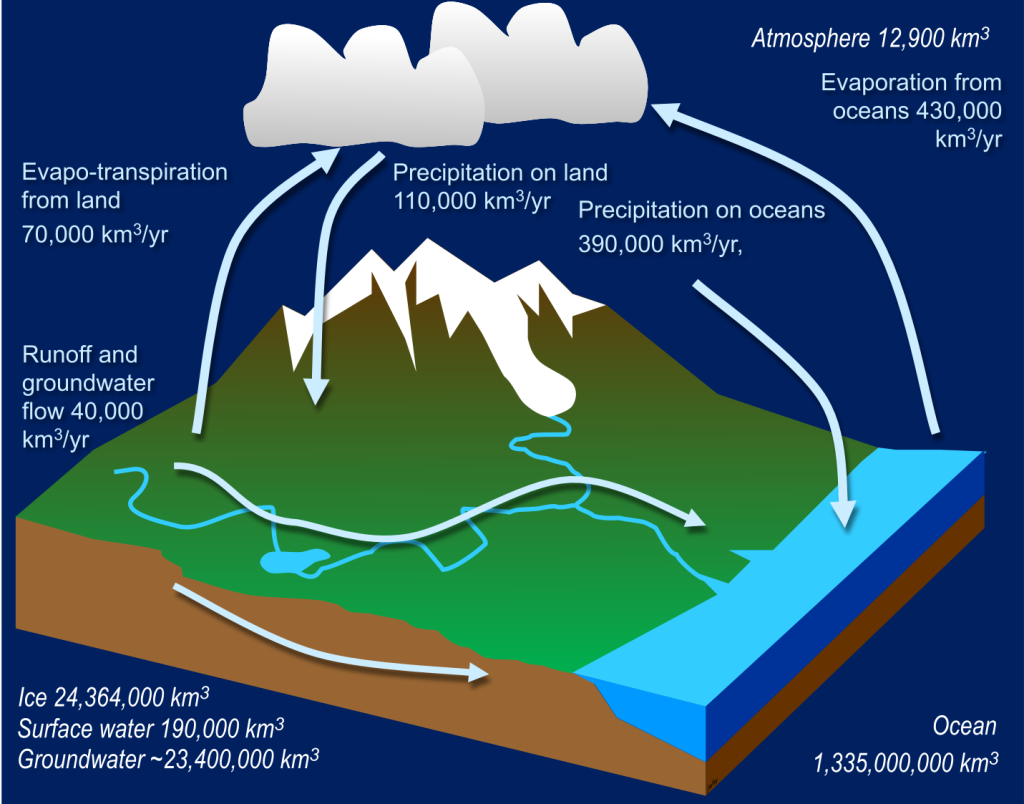
Represented like this, the water cycle is in balance – the total amount of water added to and removed from each reservoir is about the same, so the size of each reservoir remains constant over time. This is a reasonable representation of the long-term stability of the hydrologic cycle (over thousands and millions of years).
We can calculate the residence time of water in each reservoir, the average length of time a water molecule spends there. To do this, we divide the volume of the reservoir by the rate of flow in or out. There are extreme variations in residence time between the various reservoirs. For example, the residence time of water in the Atmosphere is less than 10 days, whereas the residence time of water in the oceans is 2,670 years.
What about human impacts on the Hydrosphere? One common question is, how much of that water is used by people? Answers vary, but one set of figures suggests that humans directly intercept about 4,400 km3/yr of surface water, or about 11% of the total. If we add in all the water that is transpired from crops in agricultural landscapes, the figure rises to around 22,400 km3/yr, or about 20% of the water that falls on the land surface. It’s important to realise that water that is “used” by humans doesn’t leave the water cycle – it is just diverted from one part of the cycle to another.
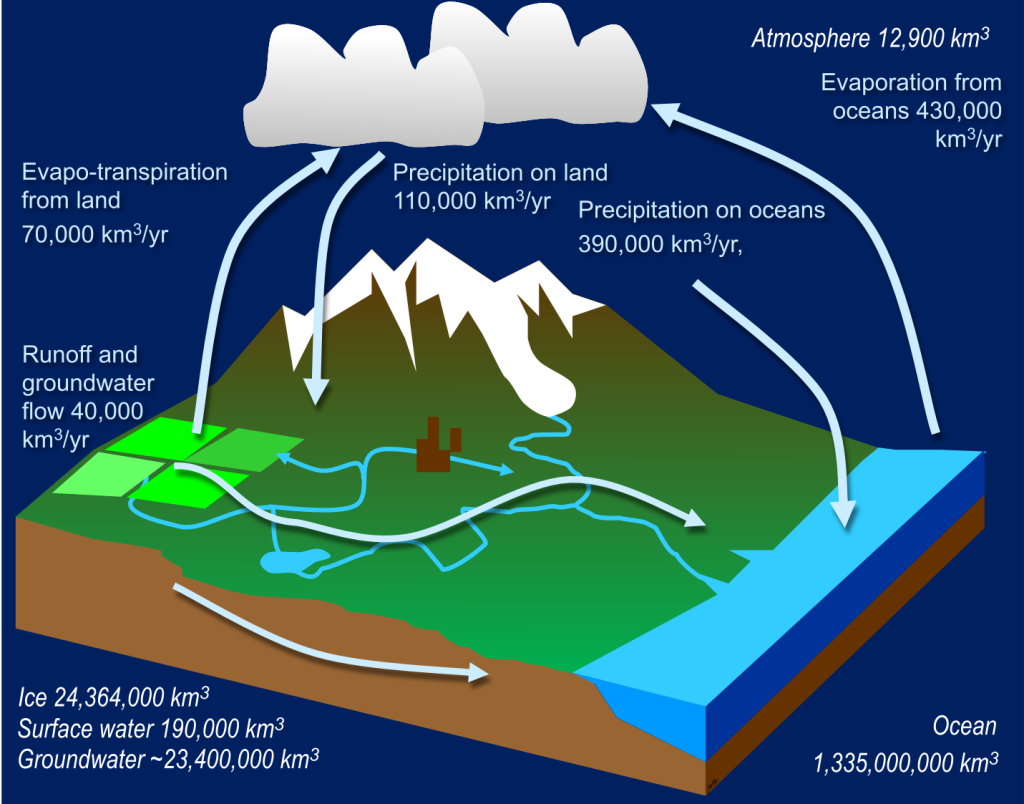
Another human-influenced impact on the water cycle is the effect of climate change. Global warming has produced a situation where the input of new snow and ice to glaciers occurs at a rate less than the rate of melting. As a result of this forcing, the size of the ice reservoir is shrinking over time, as is the residence time of water within it.
Changes in the water cycle have huge impacts on the availability of water for human populations. Only by understanding the behaviour of the water cycle as a whole can we hope to address these problems.
- Estimates for all these quantities vary as techniques are improved, though there is consensus on the approximate amounts. Values here were downloaded 2022-08-16 from https://en.wikipedia.org/wiki/Water_distribution_on_Earth ↵
- Additional water is present in the geosphere as bound molecules and ions within the chemical structure of minerals. We are not including this water here as it mostly doesn’t participate in the water cycle on a human time scale, though it's important to consider in studying some aspects of Earth evolution over billions of years. ↵
A portion of the universe that can be regarded as separate from its surroundings for some scientific purpose.
The envelope of gas surrounding a planet
All the free water on Earth, in the forms of water vapour, liquid water, and solid ice.
The Earth system that comprises all living things and their non-living remains
The solid Earth
The Sun and all of the natural objects (including planets, their natural satellites, dwarf planets, comets, asteroids and meteoroids) in its orbit.
A system that exchanges energy but not matter with its surroundings
A system that exchanges both matter and energy with its surroundings
The system comprising the human species and the parts of the Earth that humans have modified
The central part of the Earth below about 2900 km from the surface, composed largely of metallic iron
The layer within the Earth or other inner planet that overlies the core and makes up the majority of the planet, composed chiefly of magnesium- and iron-rich silicates
A thin, surface layer of the Earth that lies above the Moho; differentiated into thicker, lighter continental crust and thinner, denser oceanic crust
A scientist who studies the Geosphere using on observations of Earth materials
The gathering of samples and information by investigators working outdoors
A scientists who studies the interior of the Earth mainly through remote sensing methods using physical properties of the Earth.
Geologists and geophysicists.
A rigid, moving part of the Lithosphere
The layer of the mantle lying beneath the lithosphere and capable of plastic flow
A compound critical for life on Earth, consisting of two hydrogen atoms and one oxygen: H2O.
A cycle describing the flow of the element Carbon through the Earth system.
The transfer of energy through the various spheres and systems of the Earth
The rate of flow into or out of a reservoir in a cycle
The average time that a molecule remains in a reservoir; obtained by dividing the size of the reservoir by the flux in or out of the reservoir
An effect that changes the balance of fluxes in a system and therefore cause the system to depart from a steady state
Masses of ice capable of slow movement over the land surface
Water that occupies spaces within the Geosphere
Water in its gaseous state, a colourless invisible gas
The conversion of a substance from a liquid state to a gas
The combination of evaporation and transpiration that transfers water vapour into the Atmosphere from the land surfaces
Water or ice condensed from the Atmosphere that falls on the Earth's surface

